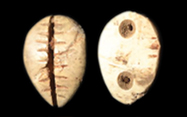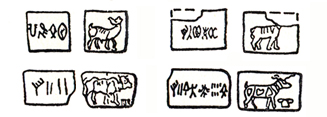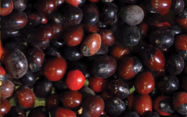
| MONEY COURIE (Cypraea Moneta) | |||||||
 |
Found in the Indian and South Pacific Oceans, this shell was the first form of currency, first appeared in the Bronze Age, around 2,000 B.C. In the 9th and 10th centuries, it was traded by Arab merchants for gold and ivory along the east coast of Africa and later by Europeans until the late 19th century. |
||||||
| INDUS SEALS | ||||||||
The first urbanization was taken place during the Indus Valley phase & some urban centers came into existence. The surplus production of raw material & finished goods, led to Barter System. The huge granaries found in the cities of Harappa & Mohenjo-Daro were replenished by the system of State tribute & served the purpose of modern State Bank. A large number of stone weights following a weight system, unit of which was 13 grains have been discovered which are multiples of 2, 4, 8, 10 etc. of this unit. |
||||||||
 |
 |
|||||||
This silver seal with unicorn motif is one of two found at Mohenjodaro |
Copper/Brinze Seals bearing animal motifs & script were used as money in Indus valley |
|||||||
| RATTI | |||||||
 |
Panini, Sanskrit grammarian (500 BCE), mentions that concept of coinage in India existed much earlier than 500 BCE. He mentions Satamanas (Sata = 100, manas = unit) & karshapana (sub fraction). Each unit was called �Ratti� weighing 0.11 grams. Ratti was average weight of Gunja Seed (a bright red seed with black tip). |
||||||